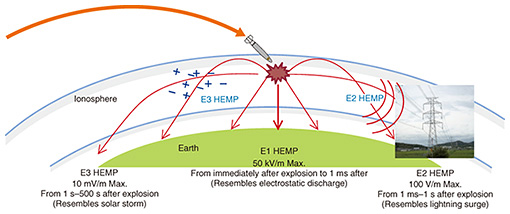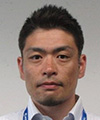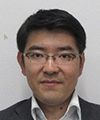 |
|||||
|
|
|||||
|
Regular Articles Vol. 16, No. 6, pp. 51–53, June 2018. https://doi.org/10.53829/ntr201806ra2 Investigating Countermeasures against High-altitude Electromagnetic Pulse (HEMP)AbstractThe threat of attack by a nuclear explosion triggering a high-altitude electromagnetic pulse (HEMP) has become an actuality. HEMP has the capacity to destroy a wide range of electric and electronic equipment. We report here on initiatives being studied to reduce the damage caused by a breakdown of communications and to restore communications promptly. Keywords: HEMP, pulse, nuclear 1. IntroductionThe recent deterioration in the international situation means that an attack by high-altitude electromagnetic pulse (HEMP) is becoming a more realistic threat. HEMP is a very powerful electromagnetic wave generated when a nuclear explosion occurs at an altitude of 30–400 km (Fig. 1). Heat rays, blasts, and radiation caused by a nuclear explosion would not reach the ground because of the very high detonation altitude. However, strong electromagnetic waves would be radiated over a wide area (radius of 1000 km) at ground level.
HEMP is capable of destroying a wide variety of electric and electronic equipment. As a result, all systems including electricity, gas, water and sewage, transportation, broadcasting, and communication would be deprived of control functions and possibly break down and stop functioning over a wide geographical area [1]. In particular, disruption or severing of communications would be a major barrier to restoration and further exacerbate the initial damage. Therefore, the most important task is to devise countermeasures to HEMP in order to protect communication equipment. One effective countermeasure would be to protect key facilities by installing electromagnetic-wave shielding and noise filters in equipment. However, from a cost perspective, it is impossible to protect every piece of equipment. Therefore, in the first instance, it is essential to clarify the possible flow-on effects of disruption to communication equipment caused by HEMP and to consider appropriate (necessary and sufficient) protective measures. Specifically, we first have to know the maximum intensity of HEMP that equipment might be exposed to (the required proof stress for the equipment), and the intensity of electromagnetic waves that the equipment can withstand without failing (the actual proof stress of the equipment). Then, if the actual proof stress of the device is below what is required, necessary measures to compensate for the shortfall revealed by the proof stress test will have to be taken. 2. Countermeasures against HEMP to protect telecom equipmentHere, we explain the issue of required proof stress and actual proof stress of equipment. 2.1 Required proof stress of equipmentHEMP has been discussed at various academic conferences and standardization meetings since the 1990s, and in 2009, Recommendation ITU-T K.78 “High altitude electromagnetic pulse immunity guide for telecommunication centres” was approved by the International Telecommunication Union - Telecommunication Standardization Sector (ITU-T) Study Group 5 [2]. This standard describes the proof stress requirement for telecom and power equipment for each way (seven ways in total) in which HEMP can affect them. However, the proof stress required for the equipment depends on the environment in which the equipment is installed (such as the building structure and the presence or absence of countermeasures against lightning strikes). Therefore, we are evaluating the equipment installation environment based on the NTT Standard Operation Procedure and past electromagnetic wave measurement results. 2.2 Actual proof stress of equipmentTo measure the proof stress of equipment, it is necessary to expose the equipment to an electromagnetic pulse imitating HEMP. However, the electromagnetic pulse created by HEMP is extremely strong and has a very steep rise characteristic, so determining how to generate the pulse and expose the equipment to it is a challenging task. 3. Future plansWe are currently evaluating the communication device installation environment, examining the electromagnetic pulse application test method, and building a test environment in cooperation with the NTT EAST Technical Assistance and Support Center. Going forward, we plan to collaborate with the Disaster Prevention Planning Office of each of the NTT operating companies and carry out proof stress tests on various kinds of equipment. References
|
|||||





